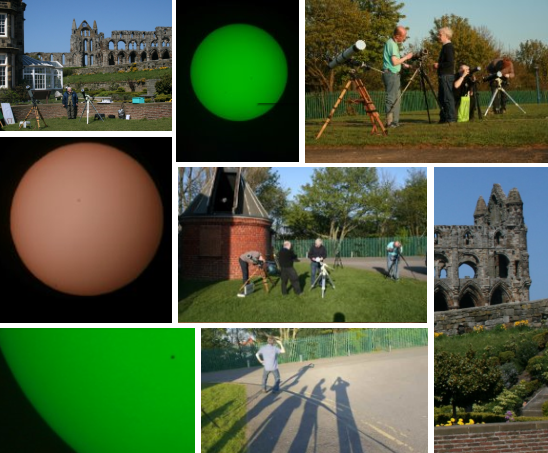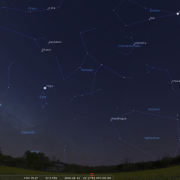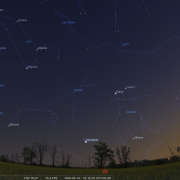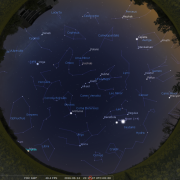Welcome to the WDAS monthly newsletter for June 2016: a digest of the month's latest contributions to our website. Below you'll find Society News, Sky Notes and In-Focus articles printed in full. There's also future events, and trailers for other articles which appear in full on the website - just a click away!
On the website you'll also be able to comment on articles, and if you'd like to play an editorial role in creating new content, just let us know!
Society News
 The Transit Party at Whitby Youth Hostel did allow Mark to schedule in some star party dates there. Both dates for May were clouded out, so the next date is June 10th (Friday) from 9pm – initially solar viewing, then lunar, and finally planetary observations.
The Transit Party at Whitby Youth Hostel did allow Mark to schedule in some star party dates there. Both dates for May were clouded out, so the next date is June 10th (Friday) from 9pm – initially solar viewing, then lunar, and finally planetary observations.
The following evening a star party is scheduled for the West Cliff as per usual. Weather permitting of course.
Well, would you believe it, a transit untroubled by the weather? Yes, it was true, you weren’t dreaming, for all seven-and-a-bit hours, Mercury remained visible against the Sun’s disk, as hardly a cloud dared show its face in the sky. Mark ventured up to the Whitby Youth Hostel with a couple of refractors, setting up in the rear garden in ‘most agreeable’ surroundings and a backdrop probably unmatched anywhere in the country, ie the Abbey.
We have a whole gallery full of Eclipse Event photos on the website. Have a look!
And have a look on YouTube for a video compilation Keith made of his photos.
There weren’t that many people around, but it was a pleasure just to be able to observe, take a photo, many photo’s in fact, experimenting with different methods, and all in peaceful calm surroundings . One member, Ray, did make the journey up, and after many years trying, was finally rewarded in seeing Mercury’s small black silhouette. The Youth Hostel staff were also thrilled to view the event.
After a couple of hours it was time to de camp and move over to the Bruce Observatory to join Keith and other fellow society members following proceedings there. Keith had been able to sneak out from college, setting up the Cooke Scope to project the image onto a card. Mercury could clearly be distinguished. Outside, John R, John L, Warren, Lee, Rosemary and several members of the public were enjoying the view through several filtered scopes.
Again, there was much experimentation with camera to eyepiece photography, with varying degrees of success. Through John L’s solar scope, a few small flares were spotted on the solar limb, however all scopes revealed the rash of sunspots present, adding to the overall occasion. As the sun began to slip down in the west, projections using the Cooke came to a premature end, the Sun being hidden by the adjacent class room block.
Eventually all the refractors had to be moved onto the top field to follow the last stages of the transit. It then became a countdown exercise as Mercury reached 3rd contact, five minutes later the tiny notch disappeared and at 19:39h the transit was over. Three more transits are visible before the next May transit in 2049. However the first, in three years time, is not visible from the UK, we’ll have to wait until 2032. It was therefore a pleasure to be able to follow this transit so completely and unhindered.

14-May-2016: A picture of the Eurovision Song Contest 2016, taken by Warren on West Cliff. (Actually there were definitely visitors: Warren was giving a sky tour when Andi made a brief visit during vote-counting.)
Mark totally forgot he’d provisionally scheduled a star party for May 14th – a clear evening as it turned out. Apologies therefore to Warren who single-handedly manned the telescope, and anyone else who turned out on the cliff to view Jupiter and the moon. Apparently views were very good. Mark has slapped his hands, and was sent to bed without any supper.
Sky Notes
In this month's Sky Notes:
Planetary Skylights
Three major planets are now visible in the late evening sky, Jupiter, Mars and Saturn.

 Jupiter resides in the SW as twilight deepens, an unmistakable ‘brilliant star’. Throughout June it continues to descend toward the West horizon, setting shortly before midnight. The moon lies below Jupiter on the 11th.
Jupiter resides in the SW as twilight deepens, an unmistakable ‘brilliant star’. Throughout June it continues to descend toward the West horizon, setting shortly before midnight. The moon lies below Jupiter on the 11th.
 Having just reached opposition, Mars remains a conspicuous object low to the South. The pale orange hue gives Mars away, although beware not to confuse the bright star Antares (chief star in Scorpius) which resides lower left, with the red planet. Through a telescope some surface detail is visible when ‘seeing’ allows, ie the image is stable, and so patience is required. The moon passes by Mars on the 16th and 17th.
Having just reached opposition, Mars remains a conspicuous object low to the South. The pale orange hue gives Mars away, although beware not to confuse the bright star Antares (chief star in Scorpius) which resides lower left, with the red planet. Through a telescope some surface detail is visible when ‘seeing’ allows, ie the image is stable, and so patience is required. The moon passes by Mars on the 16th and 17th.

Hubble image of Saturn, taken by Hubble on 20-Nov-1990
at a distance of 1.39bn km (860 million miles).
 Saturn also resides low to the south, to the left of Mars, coming to opposition on the 3rd of June. It will then be visible all night, although at this time of year night is pretty short. Appearing similar in brightness to Mars, the pearly white lustre contrasts well with ‘ruddy’ Mars. You will require a telescope to observe the ring system, but it is a view worth every penny of buying a scope if you don’t already own one. Look for the Cassini gap in the rings as well as several moons nearby. Titan, Saturn’s largest moon appears as a bright speck close by, orbiting anticlockwise twice a month. Our Moon resides above Saturn on the 18th.
Saturn also resides low to the south, to the left of Mars, coming to opposition on the 3rd of June. It will then be visible all night, although at this time of year night is pretty short. Appearing similar in brightness to Mars, the pearly white lustre contrasts well with ‘ruddy’ Mars. You will require a telescope to observe the ring system, but it is a view worth every penny of buying a scope if you don’t already own one. Look for the Cassini gap in the rings as well as several moons nearby. Titan, Saturn’s largest moon appears as a bright speck close by, orbiting anticlockwise twice a month. Our Moon resides above Saturn on the 18th.
Meteor Showers

The weak Ophiuchid meteor shower has two maxima, June 9th and June 20th. The zenith hourly rate (ZHR) barely exceeds sporadic levels (5 - 8 per hr) Observe post midnight. The poorly observed June Lyrids peak on the 15th/16th, again the ZHR is only 5-6 per hour.
June 2016 Sky Charts
Click each image to see a full-size Sky Chart:
|
Looking South
Mid-June - 23:00h |
Looking North |
|
Looking East
Mid-June - 23:00h |
Looking West
Mid-June - 23:00h |
|
|
|
|
Overview
9th-June - 23:00h |
|
Additional Image Credits:
- Planets and Comets where not otherwise mentioned: NASA
- Sky Charts: Stellarium Software

With bright twilight now persisting well into the night, observers of the sky should watch out for a particularly beautiful type of cloud formation seen only at this time of year. Known as Noctilucent cloud, these delicate formations appear above the northern horizon, long after sunset, often around midnight. Shining quite brightly, Noctilucent cloud is filamentary in structure, having a characteristic silvery-blue colour.
It forms almost exclusively between latitudes 50 and 60 degrees north, high in the upper atmosphere: 80 km (50 miles) up - five times higher than normal clouds. The cloud forms when water vapour condenses at the low temperatures that prevail at such altitudes onto particles suspended in the air.
More frequent sightings of Noctilucent cloud over the last 40 years may indicate that these particles could be a result of industrial pollution, perhaps from increased air traffic. As far as observers of the sky are concerned, the right type of cloud, for the wrong reasons?
 If you have not already done so, would members please find time to sign the online petition – re light pollution, set up by Wakefield Astronomical Society. This should have been sent via email to you already. Here's a link.
If you have not already done so, would members please find time to sign the online petition – re light pollution, set up by Wakefield Astronomical Society. This should have been sent via email to you already. Here's a link.
Ten thousand signatures are required for the Government to take note, and 100,000 for them to ‘really take note’. The closing deadline is July 22nd. If you know anyone else who would be inclined to sympathise with the cause, get them to sign it too.

As we head toward summer, nights grow ever lighter with the deepest level of darkness; known as astronomical twilight, absent until early August. The duration of the three ’twilight zones’ continually change from mid northern latitudes, but is perhaps most noticeable around the solstices - particularly the summer solstice.
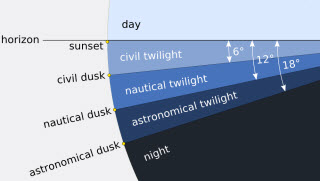 Using the evening as an example, following sunset civil twilight exists until the Sun drops six degrees below the horizon. After this point normal daytime activities cease to be possible and ‘lighting up’ time occurs.
Using the evening as an example, following sunset civil twilight exists until the Sun drops six degrees below the horizon. After this point normal daytime activities cease to be possible and ‘lighting up’ time occurs.
The next level - nautical twilight - exists when the marine horizon is no longer apparent, by which time the Sun is around twelve degrees below the horizon. In the sky only the brighter navigational stars are visible.
When the Sun drops 18 degrees below the horizon all the fainter stars become visible and astronomical twilight commences (true darkness).
During our summer, when the northern hemisphere is inclined towards the Sun, after civil twilight ends, nautical twilight persists throughout the night, with astronomical twilight totally absent.
The Sun’s apparent journey below the horizon is relatively shallow and around the summer solstice period even nautical twilight barely exists, the Sun barely dipping 13 degrees below the horizon. The further north one travels the lighter nights become, until at latitude 67 degrees N (the Arctic Circle) twilight is completely absent for the duration of summer. Here from the land of the “midnight sun” stargazing is very much limited, to just one, the Sun itself?
In-Focus

"Whitby Abbey Summer
Solstice" (taken June 2014)
Reproduced with kind
permission: Si's Photography
Click for full-sized image.
The official start of summer in the northern hemisphere commences on June 21st – the date of the summer solstice this year, when the Sun reaches its greatest altitude on the ecliptic; the path it takes across the sky during a year. From our latitude this equates to almost 59 degrees above the southern horizon at midday. The word ‘solstice’ is derived from the Greek for ‘Sun’ and ‘stoppage’. From our perspective the Sun stops moving north in the sky and starts to retreat southwards once again as the axial tilt of Earth begins to shift away from the direction of the Sun.
Many people wrongly assume that Earth is closer to the Sun at this time of year; in fact the opposite is true. Earth is actually furthest from the Sun on July 4; almost 95 million miles distant, three million miles further than when at its closest approach in early January? The reason days feel warmer in summer is due to the higher concentration of sunlight per unit area as a result of the axial tilt toward the Sun. The intensity of solar radiation is then equivalent to approximately 1.2KW of heat for each square metre, although in recent years this seems hard to comprehend?
Although known as the longest day, earliest sunrise and latest sunset do not fall on the summer solstice date. From Whitby earliest sunrise actually occurs on June 16th at 04:25am, whilst latest sunset occurs on June 25th at 21:42pm. It is the duration of useable daylight which does reach a maximum on the 21st, equating to around 17 hours from our latitude. Then the Sun only dips below the horizon a meagre 12 degrees, barely enough for nautical twilight to exist.
Thousands of years ago the position of the summer solstice stood before the stars of Cancer in the northern hemisphere, but has subsequently shifted due of the effects of precession, Earth’s slow axial wobble. From our latitude the Sun never appears overhead, but may do so anywhere between latitude 23.5 degrees North and latitude 23.5 degrees South, casting no shadows, a phenomena astronomers in antiquity duly noted. Because the summer solstice then stood before Cancer, the latitude of 23.5 degrees north eventually became known as the tropic of Cancer. Similarly then, the Sun then stood before the stars of Capricorn when at its southern limit on the ecliptic (the winter solstice) 23.5 degrees south of the celestial equator and the origin of the tropic of Capricorn.
Events
 Observe the night sky with us at the Bruce Observatory, Whitby School
Observe the night sky with us at the Bruce Observatory, Whitby School
Observing Nights are held weather permitting: check for a relatively clear sky before leaving home. If in doubt, Mark can be reached on 07886069339
Please note the college drive gate is now operated via a electronic key code - so anyone wishing to attend must be at the car park at the top of the drive by 19:00hrs - unless an arrival time has been arranged with Mark/Keith.
 Whitby School - Room H1.
Whitby School - Room H1.
In Members' monthly meetings we usually take a tour of the night sky for the coming month using the Planetarium program. Have talks and presentations on various topics of astronomy/space etc, and discuss future events etc. New members welcome.
 Observe the night sky with us at the Bruce Observatory, Whitby School
Observe the night sky with us at the Bruce Observatory, Whitby School
Observing Nights are held weather permitting: check for a relatively clear sky before leaving home. If in doubt, Mark can be reached on 07886069339
Please note the college drive gate is now operated via a electronic key code - so anyone wishing to attend must be at the car park at the top of the drive by 19:00hrs - unless an arrival time has been arranged with Mark/Keith.
 Observe the night sky with us at the Bruce Observatory, Whitby School
Observe the night sky with us at the Bruce Observatory, Whitby School
Observing Nights are held weather permitting: check for a relatively clear sky before leaving home. If in doubt, Mark can be reached on 07886069339
Please note the college drive gate is now operated via a electronic key code - so anyone wishing to attend must be at the car park at the top of the drive by 19:00hrs - unless an arrival time has been arranged with Mark/Keith.
 Observe the night sky with us at the Bruce Observatory, Whitby School
Observe the night sky with us at the Bruce Observatory, Whitby School
Observing Nights are held weather permitting: check for a relatively clear sky before leaving home. If in doubt, Mark can be reached on 07886069339
Please note the college drive gate is now operated via a electronic key code - so anyone wishing to attend must be at the car park at the top of the drive by 19:00hrs - unless an arrival time has been arranged with Mark/Keith.
 Whitby School - Room H1.
Whitby School - Room H1.
In Members' monthly meetings we usually take a tour of the night sky for the coming month using the Planetarium program. Have talks and presentations on various topics of astronomy/space etc, and discuss future events etc. New members welcome.

